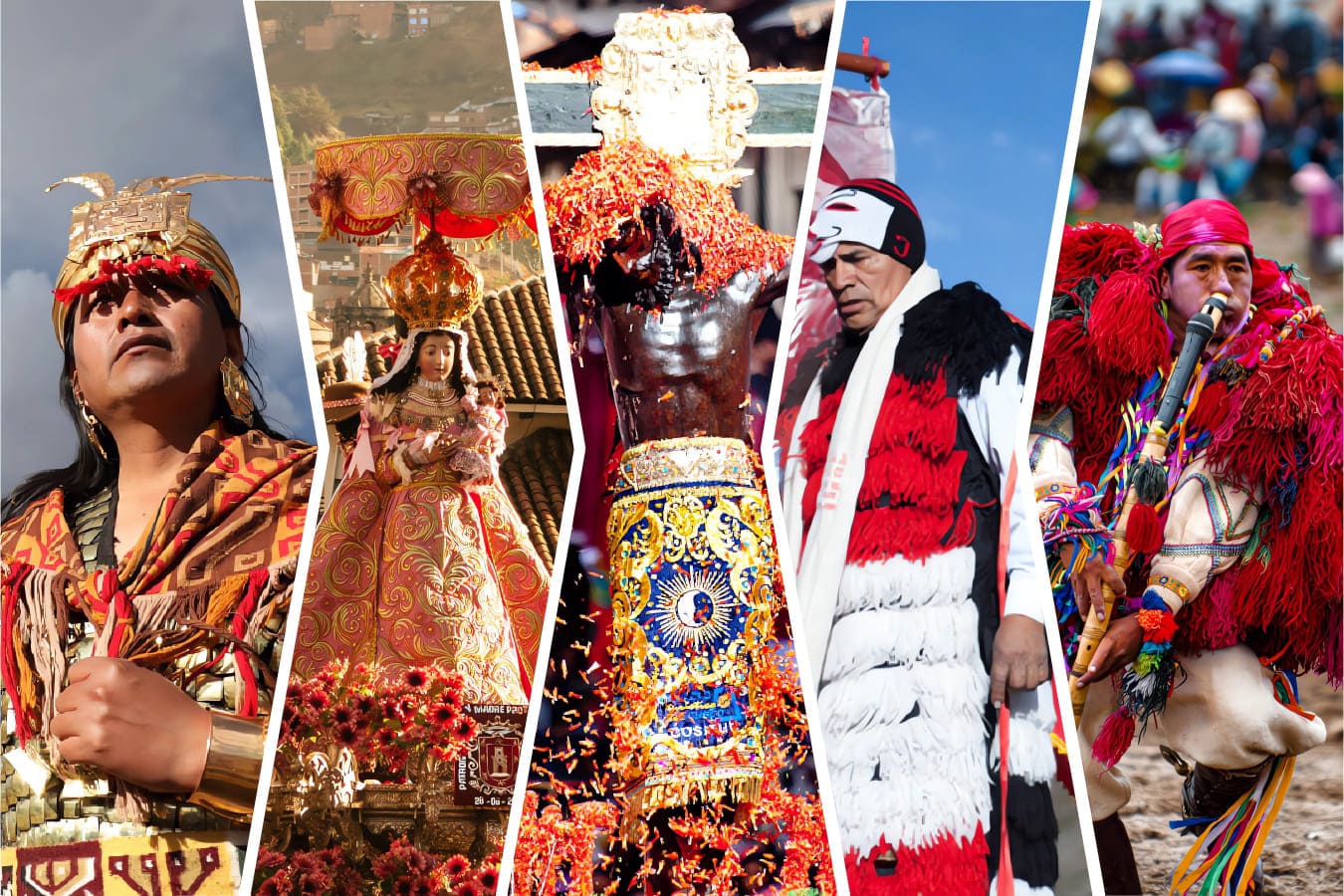

Table of Contents
Location: Plaza de Armas, Cusco
Every January 6 this ceremony takes place in Cusco’s Plaza de Armas. The event begins with hymns performed by different local choirs in honor of Christmas and the Baby Jesus.
In addition, there is the traditional dismantling of the Cusco Nativity scene, a symbolic act presided over by the city’s main authorities.
The Municipal Festival Company of Cusco (EMUFEC) organizes the award ceremony and recognition of the winning exhibitors of Santurantikuy 2025, the most representative traditional Christmas fair in Cusco.
The work of the winning artisans of the Cusco Nativity Scene Contest is also recognized; they take part every December 24 in this competition that celebrates creativity and cultural identity.
Location: District of San Sebastián, Cusco
On January 20, the traditional district of San Sebastián —one of the oldest in Cusco— fills with color, music and devotion to celebrate its patron saint.
The streets overflow with traditional dances and folkloric troupes parading to the rhythm of Andean music, creating a festive atmosphere that captivates both locals and visitors.
During the celebration you can also enjoy emblematic dishes such as the traditional chiriuchu, and refresh yourself with ancestral drinks like chicha de jora.
A cultural experience that blends faith, identity and joy in the very heart of Cusco.
Location: Cusco
Cusco fills with satire, color and playful humor during the traditional Compadres Celebration, a date that reinforces the Andean godparent bond with plenty of humor and popular creativity.
Throughout the day it is common to see rag dolls hanging from balconies, posts and squares. These figures, usually male, represent public personalities, politicians or neighbors from the barrio, caricatured with wit and messages that poke fun at everyday situations or social criticism.
The city pulses with music, laughter, foam and colored paint in a festive atmosphere that marks the beginning of Cusco’s Carnival, one of the most authentic and participatory in Peru.

Location: Cusco
Now it’s the turn of the comadres, women united by the special bond of Andean godmotherhood, whether as godmothers, close friends or festive accomplices. This celebration pays tribute to them in an atmosphere full of music, foam, streamers and vibrant color.
As part of the tradition, rag dolls are made and placed on balconies, posts, markets and squares. These figures represent well-known women and become a satirical expression full of humor and social critique, in true Cusco style.
Location: Plaza de Armas and streets of the Historic Center
Considered one of the most joyful and participatory festivities in Cusco’s calendar, the Cusco Carnival transforms the city into a celebration of color, dance and popular games. Although the festivities last several weeks, the main day is lived intensely.
From Compadres Thursday to the Kacharpari —the grand farewell to Carnival—, the city vibrates with troupes, parades, traditional dances, live music and playful games with water, foam and paint. The Plaza de Armas becomes the epicenter of collective joy.
Location: Throughout the city of Cusco and provinces
One week after Carnival Sunday, the Kacharpari is held, the ceremony that marks the close of the festivities. In Cusco’s historic center there are presentations of dances, music and a showcase of delicious local cuisine.
This emblematic Carnival dish becomes the star of Cusqueñan tables. Timpu or puchero is prepared with beef, potatoes, sweet potato, rice, chickpeas, corn and other vegetables. It is a hearty delight, perfect for sharing with family or friends during these dates.
In various neighborhoods in Cusco, people celebrate the traditional yunza, a festivity in which a tree is planted and decorated with gifts. While the music plays, participants dance around it and take turns striking the trunk with an axe.
The most anticipated moment is when the tree falls: whoever brings it down will be the host of the yunza the following year. A festive custom full of symbolism, cooperation and community.

Location: Qoricancha
In the imposing Qoricancha, the official ceremony is held to launch the Cusco Festivities and the countdown to Inti Raymi, evoking the grandeur of the Tahuantinsuyo and the continuity of its legacy.
The announcement is made by the provincial mayor in front of the people of Cusco, national and international media and the general public. This event marks the starting point of a season of cultural celebrations that reflect Cusco’s living identity to the world.
Holy Week is one of the most significant religious celebrations in Cusco’s calendar. Lived with deep faith and tradition, it brings together thousands of devotees who fill churches, streets and squares with symbols of reflection, gratitude and hope.
Everything begins on Palm Sunday, when families go to church carrying crosses woven with palm leaves, which are blessed during Mass. These crosses are later placed in homes as a sign of protection and spiritual renewal, marking the start of a week of reflection and popular devotion.
On Holy Monday one of the most important acts of the week takes place: the Procession of the Lord of the Earthquakes, the sworn Patron of Cusco.
On Holy Thursday the Last Supper is remembered, and many Cusqueñan families maintain the tradition of preparing twelve different dishes in honor of the twelve apostles. This custom can also take place on Good Friday, depending on the beliefs and practices of each household.
Good Friday is a day of reflection and silence. The crucifixion and death of Jesus are commemorated with special Masses, Stations of the Cross meditations and moments of deep contemplation throughout Cusco.
Holy Saturday marks the transition toward hope, in an atmosphere of quiet expectation of the Resurrection. Finally, the festivities culminate with Easter Sunday, a day of celebration of the triumph of life over death. Bells ring joyfully and Masses are held throughout the city.
During this week, Cusco experiences a unique blend of Catholic faith and Andean tradition, a truly unforgettable spiritual and cultural experience.
Location: Historic Center of Cusco
Holy Monday, the central day of Holy Week in Cusco, is lived with special intensity. On this day, the image of the Lord of the Earthquakes, Sworn Patron of the city, solemnly tours the main streets of the historic center in a procession charged with faith and emotion.
During the procession, balconies are decorated with flowers and cloths, people offer prayers, hymns and bouquets of ñucchu, an Andean flower with an intense red color that symbolizes the blood of the crucified Christ. This flower, traditionally cultivated in the region, is a distinctive element of this Cusqueñan celebration.
At nightfall, around 7 p.m., the Plaza de Armas becomes the spiritual heart of the city: thousands of people gather to receive the blessing of the Lord in one of the most moving moments of Cusco’s religious calendar. Collective energy guided purely by faith.
The ñucchu (Salvia splendens) is an ancestral flower that grows in the highlands of southern Peru. Bright red and delicately shaped, it has been adopted by the faithful of Cusco as a symbol of devotion and sacrifice. Its use in the Procession of the Lord of the Earthquakes is a living expression of the fusion between Andean spirituality and Catholic tradition.
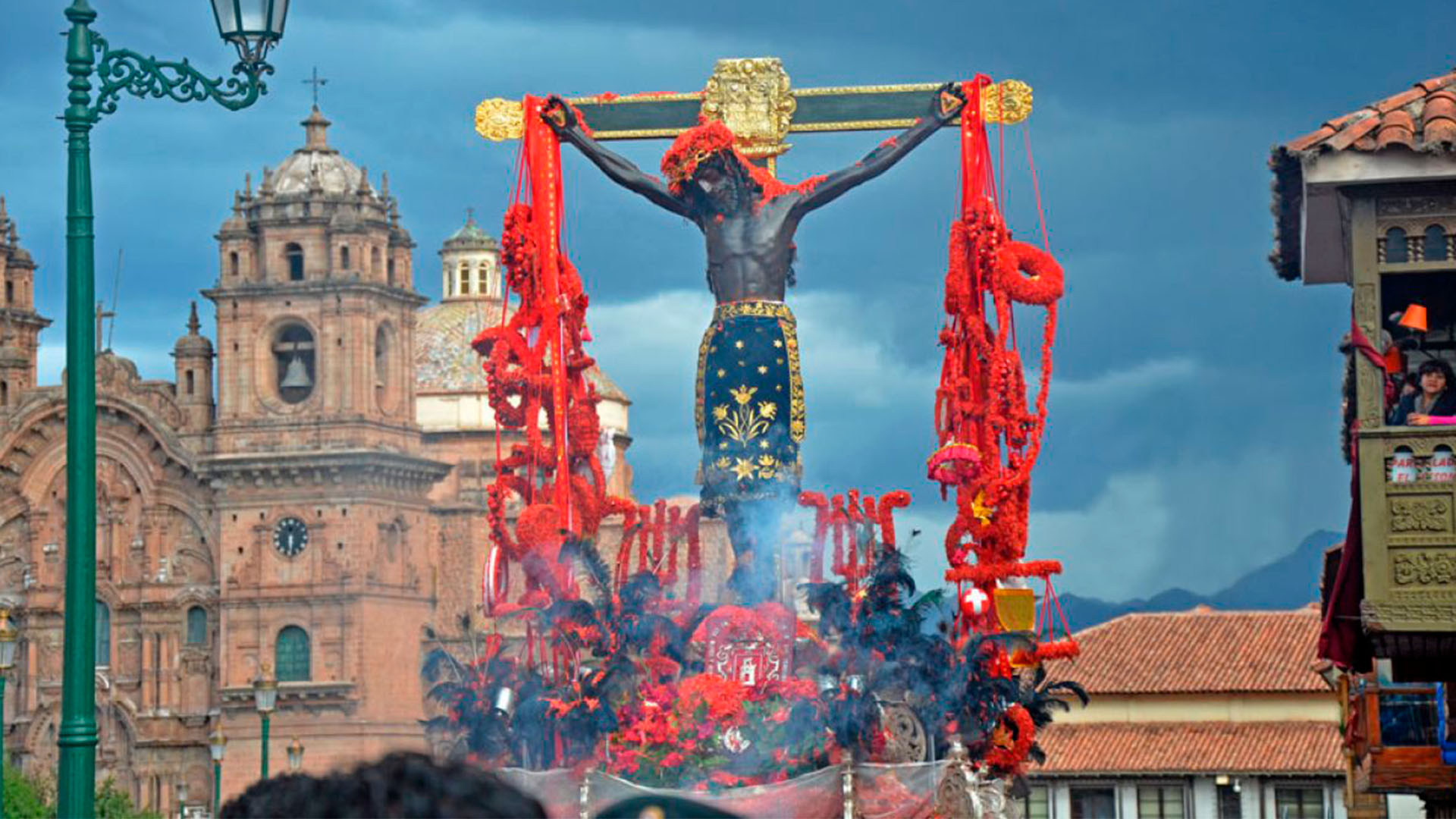
Location: Traditional neighborhoods of Cusco
Cruz Velacuy, or the Vigil of the Cross, is one of the most heartfelt religious festivities in Cusco’s traditional neighborhoods. This celebration blends Christian devotion with Andean beliefs in a symbolic act of respect and connection with the apus, or sacred mountains.
On this date, crosses —often brought down from the heights— are placed in chapels or central spaces in the neighborhoods, where they are kept in vigil throughout the night with prayers, dances, songs, traditional food and a warm sense of community gathering.
Location: Streets of Cusco’s historic center
The city fills with energy during the Qosqo 10K – Hatun Phaway Grand Race, a sporting event that kicks off the celebrations for Cusco’s jubilee month.
Local, national and international runners cover 10 kilometers on a route that passes through emblematic places in the imperial city, promoting physical activity, healthy tourism and cultural integration. It is both a competition and a collective experience that celebrates life, movement and the Cusqueñan spirit in all its splendor.
Location: Plaza de Armas, Cusco
With an ancestral ceremony in honor of Mother Earth, the Cusco Festivities officially begin.
This day marks the start of the jubilee month with a ritual of gratitude to Pachamama, a sacred symbol of fertility and abundance in the Andean worldview. Organized by EMUFEC (Municipal Festival Company of Cusco), the event is staged in the heart of the historic center, the main square, and draws thousands of attendees, both locals and visitors from around the world.
Among coca leaves, chicha de jora and floral offerings, Cusco’s spirit renews its deepest bond with the land that sustains it.
Location: Urubamba, Sacred Valley of the Incas
In Urubamba, the spiritual capital of the Sacred Valley, one of the region’s most heartfelt Catholic celebrations is held. The Lord of Torrechayoc, represented by a cross decorated with jewelry and fine textiles, receives the homage of his faithful with Masses, processions, dances and traditional dishes. The main altar is located in the neighborhood of the same name, just 10 minutes from the town center.
For several days, religious fervor and popular joy fill the streets with fireworks, brass bands and traditional dances in a unique communion between faith and living culture.
Location: Plaza de Armas of Cusco
As part of Cusco’s jubilee month, the city’s universities pay tribute with an artistic parade full of identity. Each institution presents traditional dances and allegories that reflect its commitment to Andean culture and its bond with the community.
A parade that showcases young talent, regional pride and the vitality of a culture that lives on in every youth.
Location: Apu Ausangate, Sinakara hollow
More than a festival, it is a profound spiritual experience. Every year, around 90,000 pilgrims undertake a sacred journey to the Ausangate snow-capped mountain, one of Cusco’s most revered apus. The route begins with a section by vehicle, followed by a hike that culminates in Sinakara, a natural sanctuary surrounded by mountains.
June 17 is the main day, when devotion reaches its peak with ritual dances, songs and ceremonies that intertwine Catholicism with ancient Andean beliefs. Organized by the Council of Pilgrim Nations and the Brotherhood of the Lord of Qoyllurit’i, this event has been recognized by UNESCO as Intangible Cultural Heritage of Humanity.
The pilgrimage reaffirms the spiritual bond between people, the mountain and their age-old customs.
Location: Plaza de Armas of Cusco
Color, rhythm and tradition take over the Plaza de Armas during this vibrant parade. Dozens of educational institutions in Cusco —public and private— come together to pay tribute to the city through traditional dances. Each group showcases authentic costumes, ancestral choreography and cultural expressions that reflect the diversity and richness of Andean peoples. A spectacle that not only honors the past, but also inspires new generations to keep their heritage alive.
Location: Plaza de Armas, Plaza San Francisco, Cusco
The Corpus Christi Entrada in Cusco is one of the most important and visually striking celebrations in the Andean festive calendar. Every year, on the eve of the main day, 15 images of saints and virgins are carried through the streets to Cusco’s Cathedral in a procession of music, dance and devotion that attracts both locals and tourists from around the world. This syncretic festival combines Catholic tradition with Andean beliefs, becoming a truly unique spectacle.
Location: Plaza de Armas, Cusco
Corpus Christi 2025 keeps alive one of Cusco’s oldest and most emblematic religious traditions. Every year, thousands of faithful and travelers gather to witness the grand procession of fifteen images of saints and virgins, carried on the shoulders of devotees from the city’s main churches to Cusco’s Cathedral. Each brotherhood organizes bands, dances and offerings that accompany the procession, creating an atmosphere of deep devotion and faith.

Location: Plaza San Francisco, Cusco
This festival is a tribute to flavor and memory. Chiriuchu —which in Quechua means “cold chili”— is much more than a typical dish: it is an ancestral fusion of ingredients that represent the richness of Peru’s ecological zones.
It is traditionally served at this time of year and brings together products such as cochayuyo, boiled chicken, alpaca jerky, Cusco sausage, fish roe, cheese, cancha (toasted corn), rocoto pepper, seaweed (kori) and corn fritters. A feast of flavors with pre-Hispanic and colonial roots that wins over every palate.
Location: All of Cusco, Andean regions in general
On June 20, when the sun reaches its lowest point in the southern hemisphere sky, Andean peoples celebrate the Andean New Year (or Machaq Mara in Aymara, Inti Raymi in Quechua) in coincidence with the Winter Solstice. It is a sacred moment of renewal and hope: the rebirth of the sun (Inti), source of life, after the longest night of the year.
In the Andean worldview, nature and time are deeply connected. That is why this day marks the beginning of a new agricultural, spiritual and communal cycle. At dawn, communities gather in ceremonial spaces, often in high places such as mountains or temples, to receive the first rays of the sun with arms outstretched in gratitude and in a plea for blessings for the new year.
This age-old rite, which is now lived with renewed pride in cities such as Cusco, Puno, (Bolivia) and other Andean regions, is also an act of cultural resistance and a tribute to the legacy of the ancient peoples of the Tawantinsuyu. In many cases it is complemented by dances, offerings to Pachamama (Mother Earth) and rituals.
Location: Plaza de Armas of Cusco
A magical night in the heart of Cusco. EMUFEC presents the show Lights and Sound Cusco 2025, a visual and musical experience that lights up Cusco’s Cathedral with light displays, live music and fireworks.
For approximately four hours or more, thousands of attendees —locals and tourists alike— enjoy an unforgettable evening framed by the festive spirit of the jubilee month. This event combines technology, art and emotion, and has become one of the most anticipated highlights of the festive calendar. The show begins in the late afternoon and ends around 10 p.m., depending on the energy of the cosmopolitan crowd.

Locations: Qoricancha, Plaza de Armas, Sacsayhuamán
The Inti Raymi is one of Cusco’s most emblematic and traditional events, celebrated every June 24. It is the central day of the Cusco jubilee month and one of the most important ceremonies in the Andean calendar.
Inspired by the ancient Inca rite in honor of Inti —the Sun god—, this event marks the winter solstice, a key moment in the Andean agricultural cycle. The ancient inhabitants believed the sun needed to be honored to ensure abundant harvests and the well-being of the empire.
The staging is divided into three main acts that take place in the most sacred sites of ancient Qosqo.
The ceremony begins in the Temple of the Sun, Qoricancha, with the appearance of the Sinchi (Commander General of the Inca Army) and his soldiers. They are followed by the Acllas, chosen women known for their grace and wisdom, considered the most beautiful in the empire.
The Tika Taqaqkunas also take part, scattering flowers along the ceremonial path where the Inca and his wife, the Qoya, advance. All of this is accompanied by the sound of quenas and pututos, traditional instruments that evoke the sacred power of music. This first act lasts approximately 30 minutes.
The royal cortege then moves to the historic Plaza de Armas, where the Sinchi, the imperial army and representatives of the four suyos of the Tahuantinsuyo are presented: Chinchaysuyo, Contisuyo, Antisuyo and Collasuyo.
The Inca and the High Priest of the Sun perform a symbolic offering at an altar set up in the center of the square, with the aim of ensuring good harvests, balance and prosperity for the empire.
This act lasts around 40 minutes and stands out for its solemnity, symbolic strength and visual majesty.
The culminating act takes place at the archaeological complex of Sacsayhuamán, one of the most impressive constructions of the Inca legacy. Here the largest gathering of musicians, dancers, priests and representatives from the four regions of the empire takes place, each group entering with its own dances.
Various offerings are performed, including the symbolic sacrifice of a llama, considered the main rite of the ceremony. The final scene is crowned by a moving proclamation by the Inca in the Quechua language, foretelling good fortune for his people and reaffirming the bond between the earth, the sun and the spirit of the Andean people.
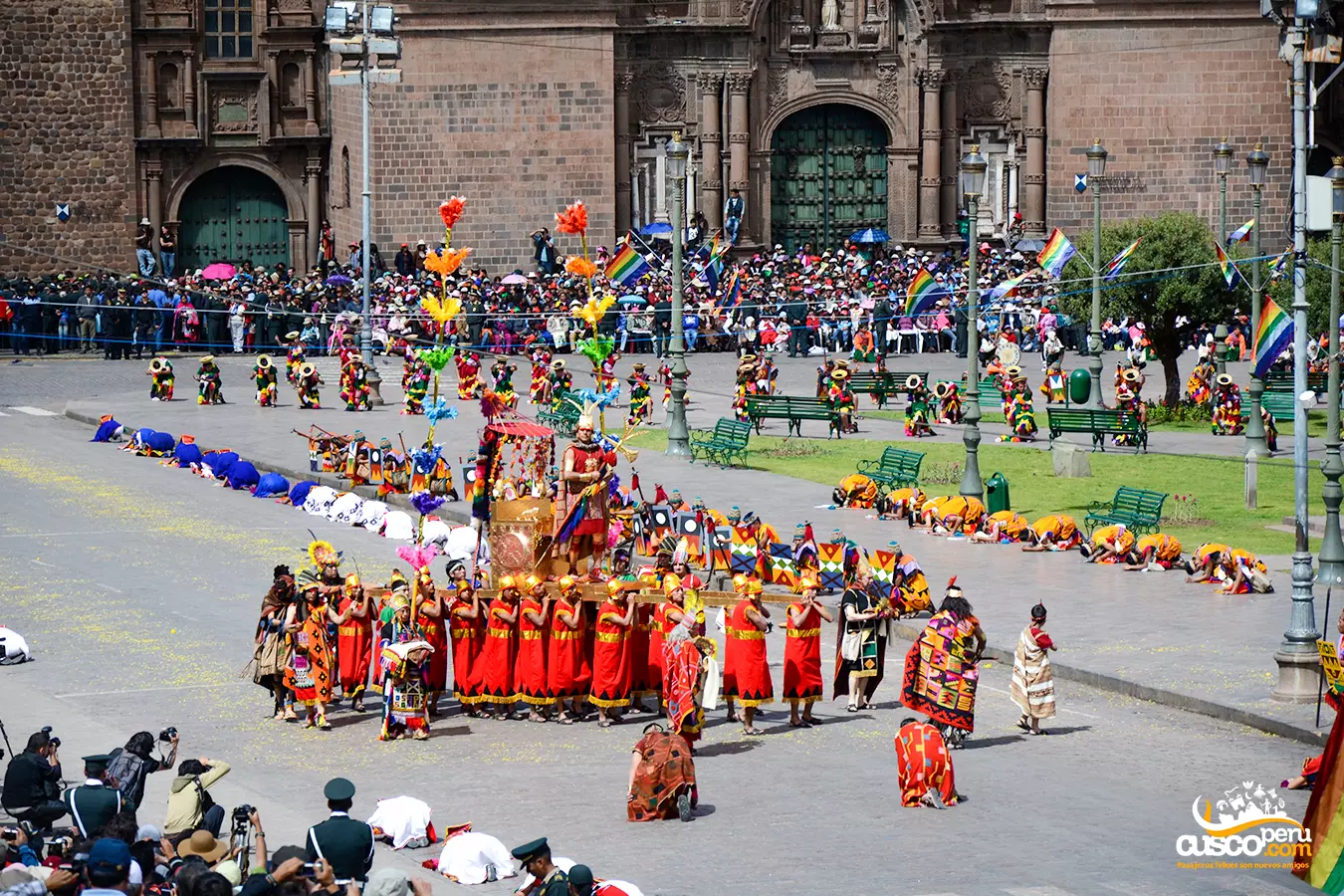
Location: Plaza de Armas of Cusco
Eight days after Corpus Christi, the sacred images take to the streets in one last procession to bid farewell to the people of Cusco. Tradition says that during these days, the saints “have been talking” about the behavior of their devotees.
The Octave represents the closing of this celebration before each image returns to its temple. A solemn farewell that reaffirms the deep connection between Catholic faith and Cusco’s cultural identity.
Location: Paucartambo, Cusco
For three days the quiet province of Paucartambo becomes an epicenter of faith, culture and color. Every July 16, the festival of the Virgen del Carmen, affectionately known as “Mamacha Carmen”, is celebrated. It is considered the second most important folkloric celebration in Peru, after the Virgen de la Candelaria in Puno.
Thousands of devotees and visitors travel from Cusco —on a journey of about two hours or a little more— to pay homage to the town’s spiritual patroness. The streets fill with troupes, brass bands and a solemn procession that crosses the heart of the town. More than a dozen groups portray characters with their own costumes and choreographies, especially the famous saqras: figures with demonic masks that playfully interact with the crowd, representing the eternal struggle between good and evil.
In recent years this festival has crossed borders thanks to its spirituality, its deep Andean-Christian symbolism and the vibrant energy that fills every corner of the town. A transformative experience that combines devotion, oral tradition, ritual dance and folk art in a high Andean setting.
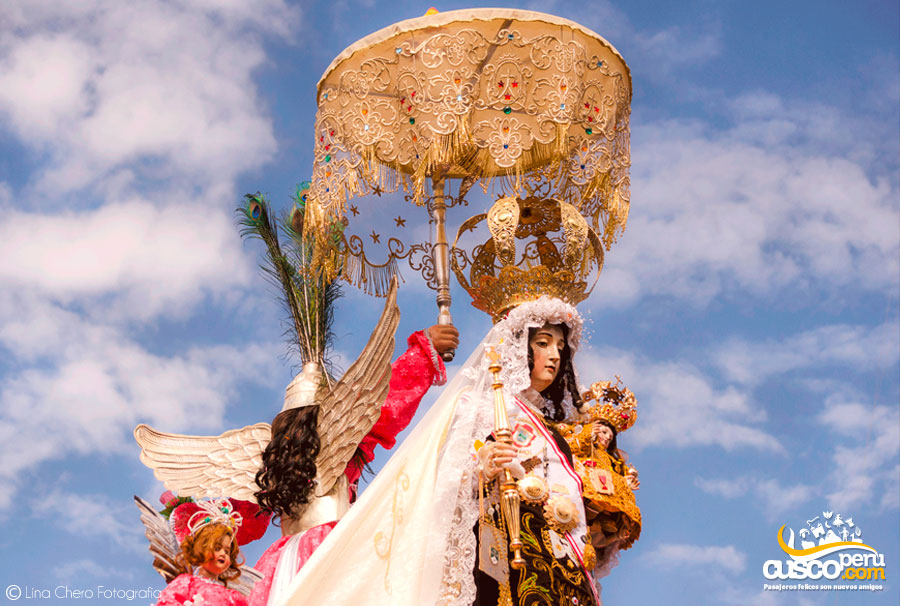
Location: Plaza de Armas of Cusco
Cusco joins the entire country in celebrating Peru’s independence anniversary with an impressive civic-military parade. Every July 28, educational institutions, state entities, police and military forces march through the main square in honor of the homeland, under the gaze of local authorities and citizens.
The day begins with a Mass in Cusco’s Cathedral, followed by the solemn raising of the Peruvian flag. Martial bands, dress uniforms and civic enthusiasm fill the historic center, recalling the legacy of freedom that unites all Peruvians.
Location: Plaza Regocijo, Cusco
A tribute to Peruvian flavor in the heart of the Inca capital. Cusco Invites is a public gastronomic event organized by EMUFEC with the participation of renowned local chefs and the support of cultural institutions.
During this celebration, Plaza Regocijo becomes a great corridor of flavors where visitors can taste emblematic dishes from Cusco and Peruvian cuisine.
The festive atmosphere is rounded out with live music, traditional dances and an ambiance that celebrates the culinary diversity of Peru.
Cusco, recognized as one of the country’s most important gastronomic destinations, opens its kitchens to the world in this encounter of tradition, creativity and flavor.
Location: All of Cusco
The first of August marks a sacred date in the Andean calendar: Pachamama Day. Since ancestral times, Andean peoples have made offerings to Mother Earth, giving thanks for what they have received and asking for abundance in the new agricultural cycle.
In Cusco this tradition remains alive both in homes and in institutions, where symbolic ceremonies are held with deep spiritual respect. Offerings include chicha de jora, coca leaves, cigarettes, sweets —and sometimes port wine— along with other ritual elements passed down through generations.
A custom that reaffirms the spiritual bond between the earth, human beings and the universe.
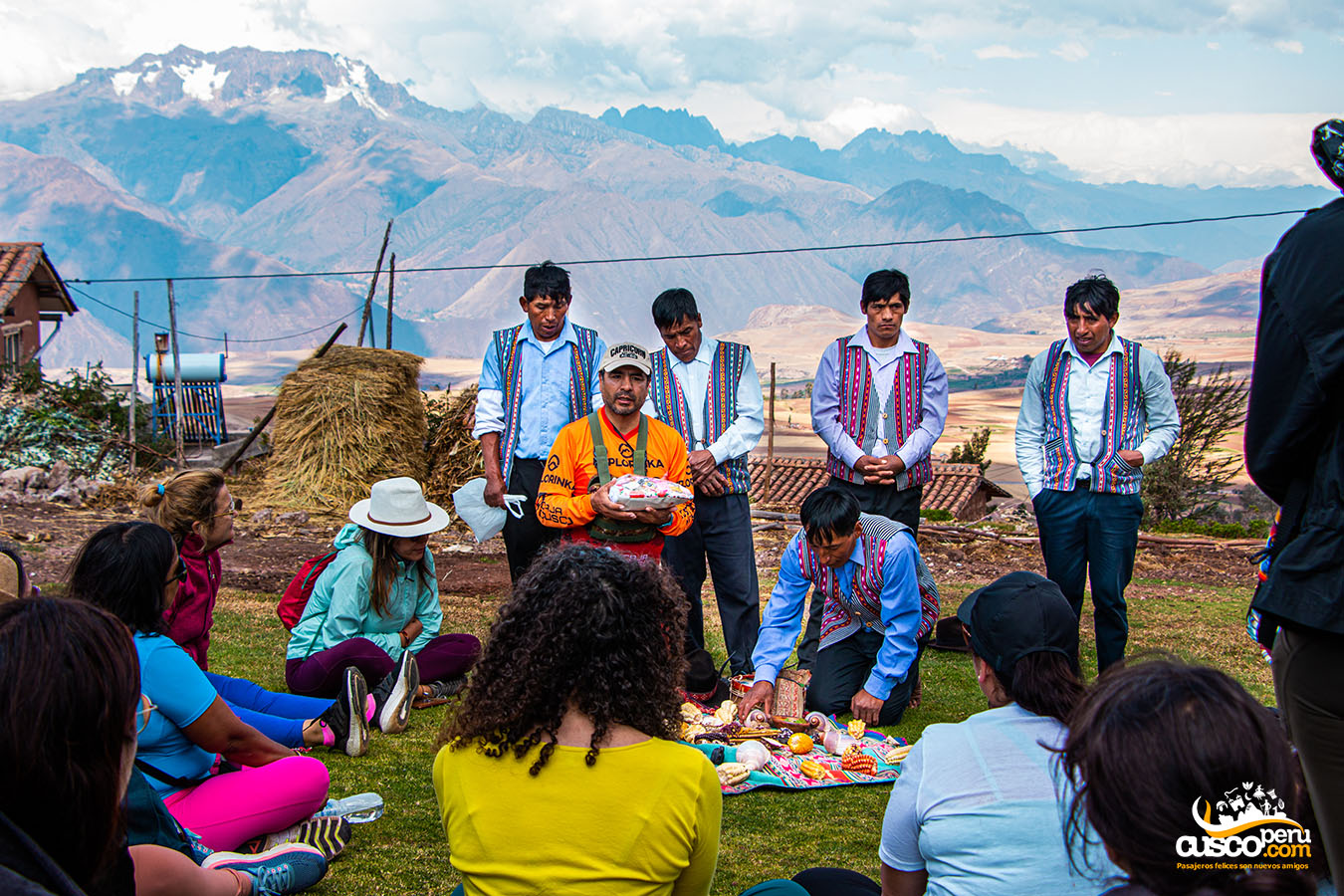
Location: Plaza San Cristóbal, Cusco
Devotion to the patron saint of drivers is celebrated joyfully in Plaza San Cristóbal. On this day, the church courtyard fills with music, dances and religious expressions. The celebration includes cultural activities, Masses, food fairs and craft exhibitions in an atmosphere that brings together tradition and community.
Bands, the color of traditional costumes and popular faith turn this event into a vibrant day in which the saint protector of the road is honored.
Location: Calca and Pisac, Sacred Valley
Known as Mamacha Asunta, Our Lady of the Assumption is the patron saint of Calca and one of the most cherished Marian icons in the Sacred Valley. Her feast is celebrated with joyful dances, lively choreographies and expressions of popular faith that attract local visitors as well as national and foreign tourists.
The streets fill with troupes, fireworks and religious fervor in a setting surrounded by mountains and tradition. This celebration blends the sacred with the festive and leaves an indelible mark on all who take part.
Location: Taray, Calca, Pisac, Tinta (Canchis)
The feast in honor of Saint Bartholomew is celebrated with songs, dances and traditional music performed with bandurrias and quenas.
This traditional celebration takes place mainly in the district of Tinta from August 22 to 26 and is also observed in other localities of the Sacred Valley.
It is a festival that stands out for its rural and community essence, where dances, faith and a sense of belonging intertwine in a vibrant tribute.
Location: Plaza de Armas of Cusco
The Patroness of the Americas and the Philippines, Santa Rosa de Lima, is honored with a civic-religious ceremony in Cusco’s main square. Civil, military and police authorities, along with institutions that have her as their patroness, take part in a parade that combines solemnity and religious pride.
This festivity, celebrated throughout the country as a national holiday, stands out in Cusco for the presence of the Peruvian National Police and other security forces who pay tribute to their protecting saint. Here devotion, history and patriotism come together in the heart of the city.
Location: Almudena neighborhood, Cusco
Almudena, one of Cusco’s oldest and most traditional neighborhoods, fervently celebrates the Virgin of the Nativity, one of the city’s most beloved images. The festivities begin on August 29 with the traditional entrada de flores (flower procession), which starts at Plaza San Francisco and ends at the Almudena church, filling the streets of the historic center with color and fragrance.
On the main day, September 8, there are solemn Masses, music and folkloric dances that accompany the Virgin’s procession through the neighborhood. It is a deeply emotional celebration where faith and tradition intertwine in one of Cusco’s oldest corners.
Location: District of San Salvador – Sanctuary of Huanca, Cusco
Every September 14, thousands of devotees travel to the Sanctuary of the Lord of Huanca in the district of San Salvador, 48 km from Cusco. The image of the martyred Christ is a symbol of healing, faith and hope, and draws pilgrims from all over Peru and abroad.
Many faithful complete the entire journey on foot as an act of penance or gratitude. The route, surrounded by nature and spirituality, becomes a collective encounter of faith. The sanctuary, nestled in the mountains, is one of the country’s most important pilgrimage centers.
Location: Mollepata, province of Anta
The Lord of the Exaltation is venerated with great devotion in Mollepata, where communities from across the province of Anta gather every year. This festival, deeply rooted in the popular feeling, brings together hundreds of pilgrims from different parts of Cusco to take part in Masses, processions and celebrations with music and dances.
Location: Plaza of the district of San Jerónimo, Cusco
The feast in honor of Saint Jerome, patron of the district that bears his name, is one of the most representative religious celebrations of the month. Not only do residents of San Jerónimo take part, but also troupes and delegations from nearby districts in Cusco.
The program includes folkloric dance competitions, music festivals, art exhibitions and food fairs that showcase the best of local culture.
Location: Historic Center of Cusco and districts such as San Sebastián and San Jerónimo
Although the main celebration of the Lord of Miracles takes place on October 28 in Lima, in Cusco activities begin on October 1 with the inaugural Mass of the purple month and the blessing of habits. The main day in Cusco is October 18, with processions that travel through various streets of the city, including visits to institutions and penitentiary centers. The purple month ends on October 31 with a special Mass.

Location: Historic Center of Cusco
Although Creole music originated in Lima —specifically in the Barrios Altos—, the celebration of this musical expression has also taken root in Cusco. Every October 31, the historic center fills with coastal music, traditional dances and cultural activities that pay tribute to the Creole spirit.
Open-air concerts, marinera performances and displays of traditional Peruvian food blend with Cusco’s heritage in a day that honors one of the most authentic expressions of national identity.
Location: Oropesa, Cusco
A celebration in which Catholic and Andean elements come together with profound tenderness and symbolism. On this date, homes and cemeteries in Oropesa are filled with altars dedicated to the deceased, decorated with flowers, candles, fruits, sweets and the emblematic t’antawawas: breads shaped like children, horses or other figures that represent the cycle of life.
The atmosphere is festive and family-oriented, with tables laden with roast pork, tamales made from Cusco corn and other traditional dishes. In squares and markets such as Plaza Túpac Amaru, food stands abound, offering these flavors that connect generations.
Location: Cusco and rural communities
Continuing the All Saints’ Day celebrations, the Day of the Dead is an intimate day on which families honor their deceased loved ones. Altars are set up at home with objects, photos and the favorite foods of the departed, in the belief that they return to share time with their families. This tradition is especially meaningful in Cusco’s rural communities.
Location: Plaza de Armas of Cusco
On Christmas Eve, the Plaza de Armas turns into a large Andean market that celebrates faith and folk art. Santurantikuy, which in Quechua means “buy me a little saint”, is a traditional fair that brings together hundreds of artisans from Cusco and other provinces, who display their finest creations: Nativity scenes, religious figures, textiles, ceramics, carved wooden objects and Christmas ornaments.
Beyond shopping, it is an opportunity to experience Christmas in an Andean key, where spirituality, creativity and tradition come together in one space.

Location: Plaza de Armas of Cusco
Ringing in the New Year in Cusco is a mystical, vibrant and deeply collective experience. On the night of December 31, the Plaza de Armas becomes a huge stage where locals and travelers gather to celebrate with music, dances, rituals and fireworks.
At midnight, Andean tradition takes center stage: people walk in circles around the square to attract good omens and positive energy. It is not just about changing the calendar, but about renewing the spirit in a city that vibrates with history, faith and hope.
As part of the most popular rituals, many people undergo flowering baths, prepared with herbs, flowers and essences intended to cleanse negative energies and attract well-being. Others choose to wear yellow underwear, a symbol of good luck and abundance for the year that begins. In Cusco, New Year’s is lived with an open soul and uplifted heart.

Happy passengers